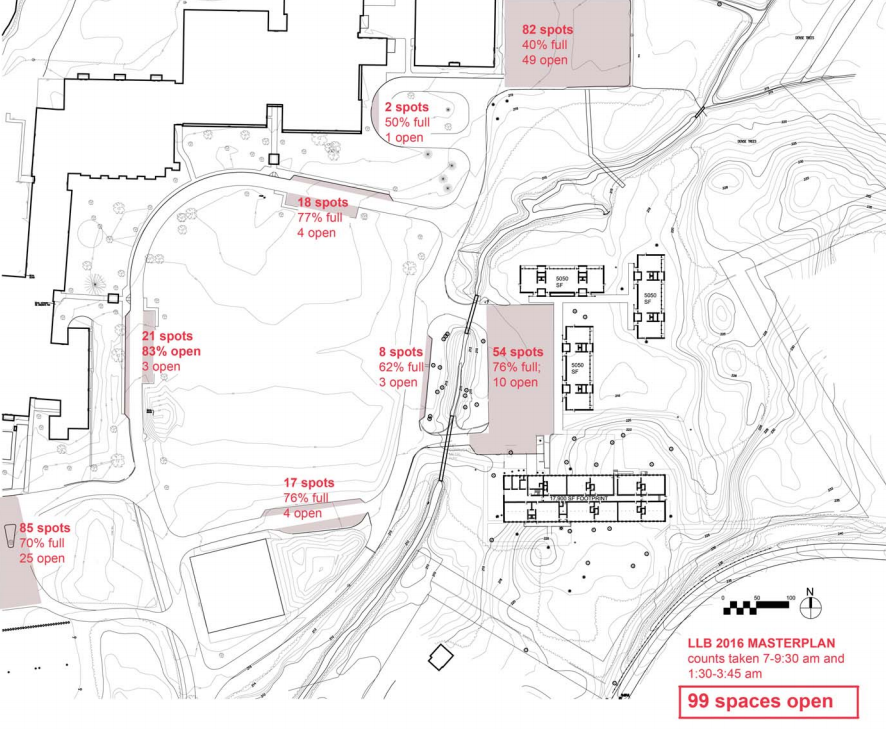
The current layout of the Hartwell area and the available parking on the Ballfield Road campus (click to enlarge).
The Community Center Preliminary Planning and Design Committee unveiled a series of concepts on their website on Sunday in advance of two public forums on Tuesday, Jan. 30. The building will be a new home for the Parks and Recreation Department and the Council on Aging as well as other community groups.
Residents will have a chance to examine, discuss, and comment on the concepts from Maryann Thompson Architects and the CCPPDC on Tuesday from 8–10 a.m. or 7–9 p.m. in Hartwell B pod. The concepts call for demolishing at least one of the existing pods and building a community center north of the main Hartwell building, with various configuration options for 100-110 parking spaces, compared to the current 54 spots in the Hartwell lot. Early cost estimates range from $12 million to $16.5 million.
The CCPPDC is working in parallel with the School Building Committee, which unveiled three project concepts for the Lincoln School (as well as options for repair-only and repair-and-minimal-renovation) on January 24.
Based on earlier feedback from residents, the community center architects created some preliminary designs based on guiding principles including:
- Sustainability
- Natural light and views
- A casual gathering space for the Council on Aging that is not shared with other organizations, as well as “nooks” for other small gathering spaces
- A nexus or center of activity where paths cross
- A plan that improves the overall condition of the wetlands within the Hartwell area
The plans are summarized below (click on the small images to see larger versions), with pros and cons of each concept as identified by the arhcitects. The full report can be seen here.
Scheme 1 – Central secondary green with peripheral parking ($13–15.5 million)
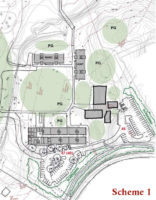 |
[tcpaccordion id=”16159″] |
Scheme 2 – Central main campus with green “L” ($13–15.5 million)
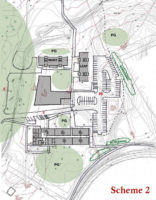 |
[tcpaccordion id=”16181″] |
Scheme 3A – Infill with peripheral parking ($13–15.5 million)
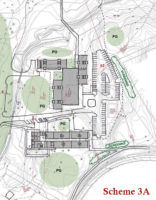 |
[tcpaccordion id=”16183″] |
Scheme 3B – Solar infill alternate with peripheral parking ($12.5–15.5 million)
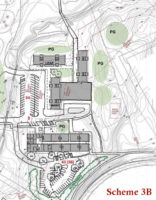 |
[tcpaccordion id=”16184″] |
Scheme 4A – Woodland path scheme with centralized parking ($13.5–16.5 million)
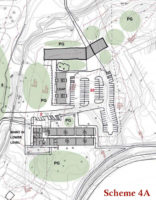 |
[tcpaccordion id=”16185″] |
Scheme 4B – Woodland path alternate with centralized parking ($12–14 million)
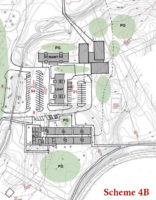 |
[tcpaccordion id=”16186″] |
If option B-6 is selected for the school, is there a Community Center solution to be considered around the Smith Gym and areas of Smith School the option would demolish?
Comments by Ken Bassett focused on site design/parking/circulation issues.
While Community Center scheme #1 has the advantage of placing the building focused on a newly created central green, the resulting configuration of parking raises serious questions of feasibility and practicality:
–the primary roadway and related parking serving Smith and the CC ends up being a somewhat torturous and challenged layout that will involve serious grading, retaining walls, and close proximity to the existing Smith facade. Parking likewise presses against the Bedford Road frontage as well as neighbor’s property calling potentially for screening and serious grading to achieve the layout.
–parking as a resource is split between Smith and the CC, creating real limits for shared parking when events call for overflow capacity. Walking between the lots, particularly in the evening, would not be convenient.
–drop-off for Smith as we know it is eliminated and relocated to a position on the other/south side of the building and intertwined with a relatively complex layout of parking. Drop-off for the CC is “left handed”. Access and parking for the pods are eliminated with the exception of a dead-end service drive.
CC schemes #2 and 3a, from a site design perspective, address the practical aspect of entry, drop-off, and parking for most facilities in the Smith quadrant. Overflow parking from a large event can be reasonably accommodated by the integrated parking layout and drop-off for Smith and The CC are straight forward and easily navigated except for the fact that a reverse movement at the Smith drop-off is not provided.
Scheme 3b suffers from the same issue as Scheme 1; that is, the split of parking resources into two disconnected areas limits flexibility. In this case the 3b is almost more problematic than Scheme 1 in that the Smith building “hides” the one parking area on the south side and probably causes patrons to first choose the existing lot then do a torturous return to access the lot to the south of Smith.
Scheme 4a is similar to #2 and #3a with its consolidated parking in a central location. The detailed layout makes the parking area look somewhat larger but in fact would be the less confusing of all other layouts and would accommodate the ebb and flow of parking demands from various activities.
Scheme 4b feels like parking has overtaken the quadrant to some extent by keeping the existing lot and adding a new lot to the east of the pod which directly serves the new CC location. Recirculation in this scheme would not be overly complex and sharing of parking resources for large activities in either the CC or Smith would work reasonably well.
Ken Bassett January 29/2018